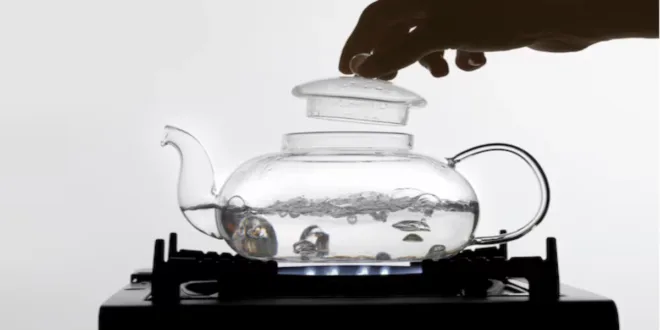Tipping Kettles: The Ultimate Solution for Safe and Effortless Pouring
In today’s kitchen landscape, the tipping kettle stands out as a unique and innovative appliance that brings both style and functionality. Designed with an ergonomic touch, it redefines how we interact with an essential kitchen item—making it safer and more accessible. Whether for home use, caregiving facilities, or busy coffee shops, tipping kettles offer a versatile solution, often considered a revolutionary design. In this guide, we’ll dive deep into what a tipping kettle is, how it operates, its unique benefits, and what to consider when purchasing one.
What is a Tipping Kettle?
A tipping kettle, as the name suggests, is a specialized type of electric kettle designed to pivot or “tip” when pouring. Unlike traditional kettles that require lifting, a tipping kettle is mounted on a cradle, allowing it to pivot forward with minimal effort. This design reduces strain on the hands and wrists, making it ideal for people with limited strength or mobility issues. The tipping mechanism allows for safe, spill-free pouring, and the kettle can be returned to its original position with a simple hand movement.
Many models also include safety features like auto-shutoff and anti-scald exteriors, making tipping kettles a top choice in elderly care facilities, for individuals with disabilities, and even in high-paced commercial environments.
Key Components of a Tipping Kettle
A tipping kettle includes several components that contribute to its functionality and safety:
- Pivot Cradle: A stable base where the kettle rests, enabling it to tilt safely.
- Handle: Ergonomically designed to allow easy grip and control.
- Pour Spout: Optimized to prevent spills or splashing.
- Boil-Dry Protection: A common feature in electric kettles, preventing the kettle from overheating if it runs out of water.
- Auto-Shutoff: Powers off the kettle when water reaches boiling point, conserving energy and adding a layer of safety.
How Does a Tipping Kettle Work?
The basic working mechanism of a tipping kettle is simple. Unlike traditional kettles that need to be lifted entirely for pouring, a tipping kettle remains securely in its cradle or base. To pour, the user gently tilts or pivots the kettle using its handle or with a push on its front, allowing the water to flow smoothly out of the spout. This “tip-and-pour” method offers precision and requires minimal physical exertion.
The kettle’s pivot cradle is engineered to stabilize the unit while pouring, so users don’t have to worry about it wobbling or tipping too far. The kettle also automatically returns to its upright position, making it incredibly easy to use.
Why Choose a Tipping Kettle? Key Benefits
The tipping kettle offers many advantages that make it stand out from conventional models. Here are some of the top benefits that have propelled its popularity:
1. Ease of Use
- The tipping mechanism of the kettle reduces the need for lifting, which can be particularly beneficial for those who struggle with grip strength or have limited hand mobility. Simply tilting the kettle minimizes strain and effort.
2. Enhanced Safety Features
- Tipping kettles are designed with safety in mind, boasting features like auto-shutoff, boil-dry protection, and anti-scald exteriors. Many models even come with thermal insulation, reducing the risk of burns during operation.
3. Ideal for Special Needs and Elderly Users
- The accessibility factor makes tipping kettles an ideal solution in caregiving environments, particularly for elderly individuals who may have difficulty lifting heavy items.
4. Efficiency and Speed
- Tipping kettles typically heat water quickly, with energy-efficient designs that reduce power consumption. The auto-shutoff feature conserves energy while ensuring the kettle doesn’t boil dry.
5. Convenience in Busy Settings
- For restaurants, cafés, and other fast-paced environments, tipping kettles streamline the process of heating and pouring, allowing staff to multitask more effectively.
Who Can Benefit from Using a Tipping Kettle?
While tipping kettles are a versatile tool for anyone who needs to boil and pour water regularly, certain individuals and settings benefit the most:
- Elderly Individuals: Reduced lifting requirements make it a practical choice for elderly users, especially those who have arthritis or other joint issues.
- People with Disabilities: The ergonomic design caters to people with limited mobility, making it easier for them to operate independently.
- Commercial Settings: Tipping kettles are ideal in busy cafes or restaurants where the staff need to quickly and safely pour hot water.
- Caregiving Facilities: Nursing homes and care facilities often use tipping kettles to enhance residents’ safety and independence.
Things to Consider When Buying a Tipping Kettle
When purchasing a tipping kettle, certain features and specifications should be evaluated to ensure you’re choosing the best option for your needs:
1. Capacity
- Tipping kettles are available in a range of capacities, from single-cup options to larger kettles for family or commercial use. Choosing the right size will depend on your daily usage and the number of people in your household.
2. Material
- Kettles are typically made from stainless steel, glass, or plastic. Stainless steel is durable and long-lasting, while glass offers a modern aesthetic. BPA-free plastic options are lightweight and often more affordable.
3. Temperature Control
- Some models feature variable temperature settings, which can be beneficial for making specific types of tea or coffee that require precise temperatures.
4. Safety Features
- Look for essential safety elements such as boil-dry protection, anti-slip handles, and auto-shutoff. These will prevent accidents and enhance the user experience.
5. Design and Aesthetics
- If the appearance of your kitchen appliances matters to you, tipping kettles come in various styles and finishes. Whether you prefer a modern look or a vintage charm, there’s a design that will suit your taste.
6. Price and Warranty
- Tipping kettles vary in price based on brand, features, and build quality. Investing in a high-quality kettle often means better longevity. Checking for warranty coverage is also advisable, as it provides peace of mind in case of any defects.
How to Use a Tipping Kettle Safely
Using a tipping kettle is straightforward, but following a few essential steps can ensure both safety and optimal performance. Here’s a detailed guide on how to make the most of your tipping kettle while avoiding common pitfalls:
1. Avoid Overfilling
- Check the Maximum Fill Line: Each kettle has a maximum fill line, typically marked on the inside wall, which indicates the safe water level. Overfilling can lead to water spillage, which may cause electric shock risks or create messes around the kettle.
- Leave Some Space: Avoid filling the kettle to the absolute brim. Leaving a little space between the water level and the fill line ensures that the boiling water doesn’t bubble over, especially when tipping to pour.
2. Regular Cleaning and Descaling
- Descale Regularly in Hard Water Areas: If you live in an area with hard water, mineral deposits like limescale can build up in your kettle over time, reducing its efficiency and impacting the taste of the water. To descale, fill the kettle halfway with equal parts water and white vinegar, then boil the mixture. Let it sit for 20 minutes before rinsing.
- Use a Soft Cloth for the Exterior: For stainless steel or glass models, use a soft cloth and mild soap to wipe down the outside after each use, which helps prevent water spots and fingerprints.
- Inspect for Residue: After each cleaning, check the spout and inner walls for any mineral residue or buildup that could interfere with pouring or heating efficiency.
3. Secure the Base and Cradle
- Double-Check Stability: Before turning on the kettle, ensure it’s firmly seated in its pivot cradle or base. A stable base is essential to prevent wobbling or tipping accidents, particularly when boiling water is involved.
- Check Pivot Points: For tipping kettles with a movable base, verify that the pivot points are in good condition and securely attached. This ensures that the kettle tips smoothly and safely when pouring.
- Keep the Base Dry: Always make sure the base is dry before placing the kettle back on it to avoid electrical risks.
4. Use the Handle Correctly
- Grip Firmly but Lightly: When tipping the kettle, hold the handle with a steady, controlled grip. There’s no need for heavy force; most tipping kettles are designed to pivot effortlessly.
- Avoid Touching Hot Surfaces: Many kettles have heat-resistant handles, but it’s still wise to avoid touching the body or the spout, as these areas can become hot.
5. Wait for Cooling Before Tipping
- Let the Boiling Settle: Once the water has boiled, give it a few moments to settle down before tipping. Boiling water can cause splashes, and waiting reduces the risk of hot water spilling out too quickly.
- Pour Slowly and Steadily: When pouring, tilt the kettle slowly to maintain control over the water flow. This not only reduces the risk of spilling but also helps prevent any accidental scalding.
6. Unplug When Not in Use
- Safety First: To avoid any risk of electrical accidents, always unplug the kettle when it’s not in use, especially after cleaning. If you need to leave the kettle for an extended period, ensure it’s unplugged and cooled down before storing.
- Cool Down Before Storage: Never store the kettle while it’s still warm, as residual heat may affect other nearby items or surfaces.
7. Inspect Regularly for Wear and Tear
- Check Electrical Components: Look over the power cord and plug to ensure there’s no fraying or damage. Damaged electrical parts should be replaced immediately to avoid potential hazards.
- Examine the Pivot Mechanism: If you notice stiffness or difficulty tipping, inspect the pivot mechanism for any obstructions. Some kettles may benefit from a tiny amount of lubricant if recommended by the manufacturer.
How to Clean and Maintain a Tipping Kettle
Proper maintenance will prolong the life of your tipping kettle, ensuring it continues to function efficiently:
1. Descale Regularly
- Mineral buildup from hard water can affect performance. To descale, fill the kettle halfway with equal parts water and vinegar, then boil. Let it sit for 15-20 minutes before rinsing thoroughly.
2. Clean the Exterior
- For stainless steel kettles, a mixture of baking soda and water can remove stains. Avoid abrasive materials that can scratch the surface.
3. Check the Pivot Mechanism
Ensure the cradle and tipping mechanism remain free of obstructions. Lubricate the pivot point occasionally if recommended by the manufacturer.
4. Inspect Electrical Components
- Frequently check the cord and plug for signs of wear. Avoid wrapping the cord tightly around the base, which can strain the wiring.
Comparing Tipping Kettles with Traditional Kettles
To make an informed decision, it’s helpful to understand how tipping kettles differ from traditional electric kettles:
| Feature | Tipping Kettle | Traditional Kettle |
|---|---|---|
| Ease of Use | Minimal effort, no lifting required | Requires lifting and controlled pouring |
| Safety | Enhanced safety features, stable base | Varies by model, often fewer features |
| Accessibility | Ideal for limited mobility | May be challenging for some users |
| Cost | Often more expensive | Generally affordable |
| Design | Ergonomic, often stylish | Varies widely, traditional shape |
Conclusion
The tipping kettle has revolutionized the way we interact with an everyday kitchen appliance, bringing safety, convenience, and accessibility to a whole new level. Perfect for anyone from coffee enthusiasts to the elderly, it offers a unique blend of style and functionality. When choosing a tipping kettle, consider factors like capacity, material, safety features, and maintenance needs. Investing in a tipping kettle not only enhances your kitchen experience but also makes it more accessible for everyone in your household.
With proper care, a tipping kettle can serve as an invaluable tool, simplifying tasks and adding a modern touch to any kitchen setup.
Frequently Asked Questions (FAQs)
Can a tipping kettle help people with arthritis or limited hand strength?
Yes, the design of a tipping kettle makes it easier to pour hot water without needing to lift the kettle fully, which is especially helpful for individuals with arthritis or limited hand strength. The pivoting base allows for minimal effort when pouring, making it a user-friendly option.
Are tipping kettles more expensive than regular electric kettles?
Typically, tipping kettles can be slightly more expensive due to their ergonomic design and additional safety features. However, many users find the extra investment worthwhile, especially for the added convenience and accessibility benefits.
How do I clean and maintain a tipping kettle to ensure it lasts?
Regular descaling, especially in hard water areas, helps keep the kettle running smoothly. Cleaning the outside with mild soap and water, and occasionally checking the pivot mechanism, can also extend its lifespan and ensure optimal performance.
Is it safe for children to use a tipping kettle?
While tipping kettles come with enhanced safety features, such as controlled pour mechanisms and heat-resistant exteriors, children should always be supervised when using any hot water appliance. The safer design can reduce accidental spills, but adult oversight is recommended.
Do tipping kettles boil water as quickly as traditional kettles?
Yes, tipping kettles are designed with efficient heating elements that boil water at a similar speed to conventional electric kettles. Some models even offer eco-friendly features that help save energy without compromising boiling speed.
Can I find tipping kettles with temperature control options?
Absolutely! Many tipping kettle models offer variable temperature settings, making them suitable for brewing specific types of tea or coffee. This feature is especially useful for anyone who enjoys different hot beverages that require precise water temperatures.
READ ALSO: G Store Asian Market: Your Gateway to Authentic Asian Flavors
 Nt Design
Nt Design




